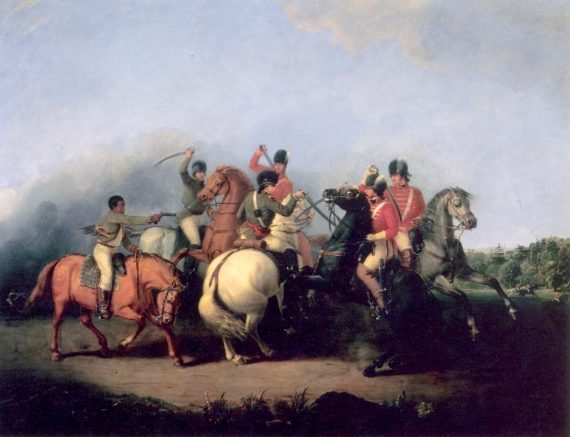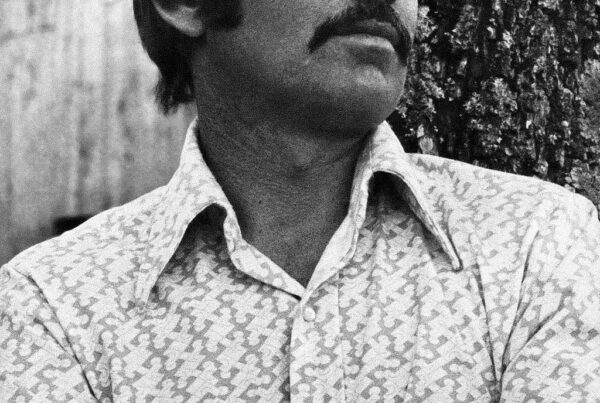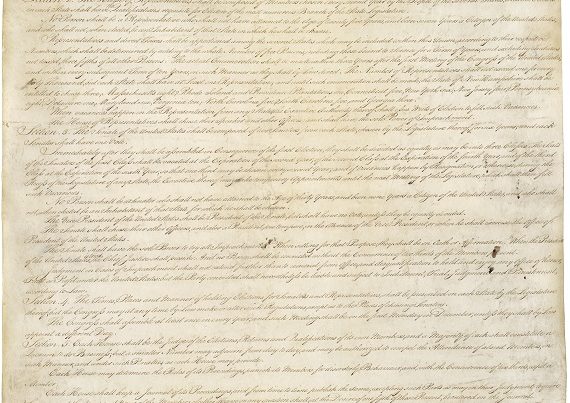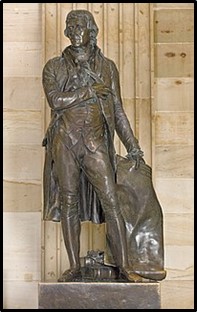
President Trump recently used his executive powers to designate a national monument to honor African Americans’ role as soldiers during the War Between the States. The monument will be a 380-acre site in Kentucky to commemorate Camp Nelson, which was one of the largest recruitment stations for the United States Colored Troops. The unfortunate reality is that the monument will probably not have any information about black Confederates. This would be a mistake by the President, as there are many black Southerners that served proudly during Late Unpleasantness. It’s also a shame to only focus on the years 1861-1865, as black Americans have been contributing greatly to military affairs since the beginning.
The American Revolution, the War of 1812, the War Between the States, and the Spanish-American War are each filled with examples of black soldiers going above and beyond the call of duty in major wars before 1900. Upon further research, it becomes evident that this tradition is arguably stronger in the South than any other region of the country.
THE AMERICAN REVOLUTION
The painting at the top is titled “The Battle of Cowpens” by William Ranney and depicts the true story of a young black servant, barely large enough to wield a sword, who saved William Washington’s life by firing a pistol at a British officer. The National Park Service has documented at least fifteen black men that fought for the Americans at the battle of Cowpens in South Carolina.
In 1783, the Legislature of Virginia emancipated several slaves that fought in the Revolutionary War. When George Washington passed away, special considerations were made in his will for a “mulatto man William, calling himself William Lee” to have immediate freedom, an annuity of thirty dollars for his natural life, and the option for William to stay with the family. According to Washington, he gave this to William “as a testimony of my sense of his attachment to me, and for his faithful services during the Revolutionary War.”
In North Carolina, the Edenton Whig once published the story of a man named Jonathan Overton who lived to be over one hundred, served under George Washington, and had fought at the battle of Yorktown. In July of 1854, South Carolina’s Charleston Mercury wrote about a man named Captain Williamson, a free black man that lived to the age of one hundred and thirteen years and received honorable notice for his service.
Our historical understanding of how white and black Americans interacted during the early republic has been fractured. For example, there is ample evidence to show that free blacks were recognized as citizens during the period under the Articles of Confederation:
“Art. 4 – The better to secure and perpetuate mutual friendship and intercourse among the people of the different States in this Union, the free inhabitants of each of these States – paupers, vagabonds, and fugitives from justice excepted – shall be entitled to all privileges and immunities of free citizens in the several States; and the people of each State shall have free ingress and regress to and from any other State, and shall enjoy therein all the privileges of trade and commerce, subject to the same duties, impositions, and restrictions as the inhabitants thereof, respectively”
With large black populations in the Southern states early on, the definitions of race were more flexible and a lot less defined than the postbellum period. For example, in 1705 the Colonial Virginia Assembly defined slaves as “all servants brought into the colony who were not Christians in their original countries, as well as Indians sold to the colonists by other Native Americans.” By 1708, South Carolina was the first English colony with a black majority and by the time Northern states began passing gradual abolition laws in the 1780s, there were already large numbers of free blacks in many Southern states.
According to the Southern doctor and historian, Miles V. Lynk (a black man from Tennessee), 3,000 blacks saw service in the Revolutionary War – with 775 serving under George Washington personally on August 4, 1778. Lynk also insists that a Black Legion of San Domingo, which consisted of over 800 blacks and mulattoes, fought alongside and saved the American and French forces from annihilation at the siege of Savannah on October 9, 1779.
THE WAR OF 1812
When the War of 1812 came to Louisiana, a free black man named Joseph Savary raised a force called the Free Men of Color of the Louisiana Militia, or the Second Battalion. Savary was a soldier from Saint Domingue who had sided with the French during the Haitian Revolution and, after the new government there began hunting French loyalists, left to settle in New Orleans. He became the first black soldier in America to reach the rank of second major, and his forces helped push the British back in December of 1814.
The force that Savary led was created after Andrew Jackson issued an appeal on September 21, 1814 calling for aid from the free black people of Louisiana. A special act of the legislature in Louisiana authorized free black troops to be raised, but only those who resided in the parish of Natchitoches and possessed real estate worth more than $150 were eligible. Andrew Jackson once praised this regiment in a letter to President Monroe, which described the Battle of New Orleans and stated: “I saw General Packenham reel and pitch out of his saddle. I have always believed that he fell from the bullet of a freeman of color, who was a famous rifle shot, and came from the Attakapas region of Louisiana.”
After 500 blacks distinguished themselves at the Battle of New Orleans, Andrew Jackson issued a proclamation stating:
“To the men of color, soldiers! From the shores of Mobile, I called you to arms. I invited you to share in the perils and to divide the glory of your white countrymen. I expected much of you for I was not uninformed of those qualities which enable you to resist the invading foe. I knew that you could endure hunger and thirst and all the hardships of war. I knew that you loved the land of your nativity and could defend all that was dear to you; but you have surpassed my hopes.” This conflict would be the only instance of black soldiers enrolling in military service from 1800-1850.
THE WAR BETWEEN THE STATES
Within academia and the media, it has become standard to deny the existence of black Confederates and label them simply as a myth. And because so many of the blacks who served the Confederacy had roles like teamsters, cooks, and musicians, the assumption is that there is not much analysis needed. The truth is much more complex and intriguing. For example, a black journalist from Charleston named W. Earl Douglas said the following about race and the founding of the Confederacy:
“If hate had been the prevailing emotion between the races, then it is a safe bet that the Confederacy would have never been born. Fortunately, there was love, understanding, and compassion…And the two greatest lies ever perpetrated by history are, number one, that the South instigated the war, and number two, that it was fought by the North for the purpose of freeing the slaves! The Negro was merely used as the excuse for that War while the real reason for it is reflected in every area of our lives where the tentacles of government form the bars of a new slavery.”
Interestingly, Douglas was a Northerner born in 1923, and only moved to Charleston because his wife was from there. But there were even prominent black men who realized these truths earlier in history. On February 23, 1890 the Daily Clarion Ledger of Jackson, Mississippi published a speech by another black Southerner named John F. Harris. This man was a legislator in Washington County, Mississippi and gave a speech to support a bill to erect a Confederate Monument in Jackson, Mississippi. Harris stated:
“When the news came that the South had been invaded, these men went forth to fight for what they believed…I too wore the Grey. The same color my master wore. We stayed for four long years and if that war had gone on until now, I would be there yet…I want it known to all the world that my vote is given in favor of a bill to erect a monument in honor of the Confederate dead.”
The roles of blacks in the Southern war effort were not always limited to non-combat roles, however. Frederick Douglass stated that black soldiers were marching around in the South ready to defend their homes and there are also countless Northern accounts, newspapers, and cartoons that show Union soldiers encountered black regiments, sharpshooters, and combatants. Another interesting account comes from Arthur Fremantle of Her Majesty’s Coldstream Guards, who visited the Confederacy in 1863 and was present at Gettysburg. One day he noticed a black man dressed in full Yankee uniform, with a loaded rifle, leading around a barefoot white man, with whom he had traded clothes. According to Fremantle, General Longstreet stopped to ask what was going on and discovered the proud black man had taken charge of the prisoner after his masters had gotten drunk and fell asleep. Fremantle was surprised by the slave’s “consequential manner” and “the supreme contempt with which he spoke to his prisoner.” This shows that indeed, there were some black Southerners that felt hate for the Yankees and were proud of their homeland.
In addition to the countless pieces of anecdotal evidence, there are also many pension applications that demonstrate how black soldiers held a variety of roles in the Confederate army. For example, the Tennessee State Library and Archives in Nashville has a record of at least 267 black Confederates claiming service in roles such as supply wagon driver, laborer, horse shoer, shoe man, commissary department, steward, hospital steward, quartermaster department, teamster, body servant, and bodyguard. Then there are examples of black Confederates that encompassed many roles, like Pvt. Hawkins Wesley Carter of the 46th NC Troops, who served for the entire war. His 1927 pension application states he “threw up breast works, worked on the railroad, cooked, waited on white soldiers, and fought seven days at the 1864 Wilderness Campaign in Virginia.” Another example might be Sam Ashe, who served as a body servant to Captain Richard Ashe at the 1861 Battle of Big Bethel, VA. According to accounts, Sam Ashe fired the fatal shot killing Union Major Theodore Winthrop and helped win the first battle of the war in the Confederacy’s favor. After January of 1862, Sam Ashe was hired out to serve the Confederacy by working on the North Carolina Railroad.
Unfortunately, we may never know for certain the exact number of black Confederates that fought for the South. With “historians” outright denying their existence, it will take a lot of time and persistence to get this topic more mainstream. But there’s ample evidence to show that there truly was “love and understanding,” as W. Earl Douglas wrote, in the South between the races. Stonewall Jackson, for example, is often considered the pride of the South and had a “Colored Sabbath School” to teach the good news of the gospel. Robert E. Lee’s wife and daughters tutored slaves in basic reading and writing when it was prohibited by Virginia law. The time has come to reinterpret how we look at race relations in the South during the War Between the States.
THE SPANISH-AMERICAN WAR
When the United States Battleship Maine exploded in Havana Harbor on February 15, 1898, over 260 American sailors were killed. Out of that number, there were 30 total “colored” men (mostly Southern) working in the battleship, 24 of which were killed. Up until the Spanish-American War, black soldiers from the South had made quite a reputation for themselves in various frontier campaigns against Indians.
The 9th Cavalry Regiment, commonly referred to as the “Buffalo Soldiers,” was recruited out of New Orleans and experienced hard fighting with Comanches, Utes, Apache, and various other conflicts. Between the period of 1870 and 1890, eleven members of the regiment received the Medal of Honor. On San Juan Hill, during the war against Spain in 1898, three of their men were killed in combat as their timely arrival helped Theodore Roosevelt’s Rough Riders take the day.
The 10th Cavalry Regiment, which assisted the 9th in taking San Juan Hill, was organized in Kansas but comprised of mostly Southerners. For example, Dr. Auther M. Brown was from Raleigh, North Carolina, and was one of the few black military surgeons of the period that stood out for his skills. He has the proud honor of being the only black surgeon to serve a regular regiment in Cuba. Sergeant Horace W. Bivins was from Hampton, Virginia, and his record as a marksman proved him one of the best shots in the army in 1885. He also won several other medals and distinguished awards for his remarkable abilities with the revolver.
Throughout the South, there were many newspapers, politicians, and community leaders advocating black soldiers for the Spanish-American War. The New York Evening Post wrote “The idea of enlisting Negroes in the South for service in Cuba seems to be in favor among the whites” and The New Orleans Picayune wrote that “…The Picayune thinks that, if the tropical possessions of the Spaniards in either the East or West Indies, or both, are to be conquered and held by the United States, Negro troops will be of the utmost importance for that service.”
One of the best organized regiments with black commissioned officers was the 3rd North Carolina. Although they did not see action in Cuba, they became distinguished here at home. Their commander was Col. James H. Young, who was born a slave in Vance County, achieved a college education, and went on to the State Legislature. He was appointed to be the major of “Russell’s Black Battalion” and ended up making his regiment one of the best drilled in the volunteer service. The regiment also had a man named Lieut. Col. C.S.L.A Taylor, who was born a slave in 1854. Taylor made shoes for General Lee’s army during the War Between the States, attended a Quaker school afterward, and was known for being a barber, musician, and dancing master. Taylor also had two sons that served in the 10th Cavalry.
In Virginia, a black editor named John Mitchel, Jr. repeatedly published editorials requesting black officers to lead the black regiments. Soon after, Governor Tyler of Virginia appointed all colored officers except a colonel, Lieut. Col., and an assistant surgeon. Unfortunately some internal squabbling and politics led to the resignation of the black officers, but the regiment of over 4,000 black volunteers marched for President McKinley while he was on his Southern tour in Macon, Georgia.
Finally, the 10th Georgia is the last regiment that deserves recognition. One company within it was recruited by a black professor named Thomas L. Cotton of Darlington, South Carolina. The regiment also had volunteers from Virginia, Atlanta, and Augusta. One of the most distinguished was Reverend Richard Carroll, a chaplain who distributed more than $300.00 worth of books among his regiment.
CONCLUSION
For too many years, the South has been portrayed as backward and racist. Studying the contribution of its black sons in combat show that the truth is much more complex. Indeed, it was possible to be black and live in the South with a sense of pride in country.
If the South is destined to someday be an independent nation, it will be impossible without the help of all its people, irrespective of race. There’s a shared experience in the South, a sort of cult of memory, that exists with all its residents. This material needs to be shared with diverse groups in order to show that the South has a proud military tradition spanning across hundreds of years, that included and depended upon many people of color.






